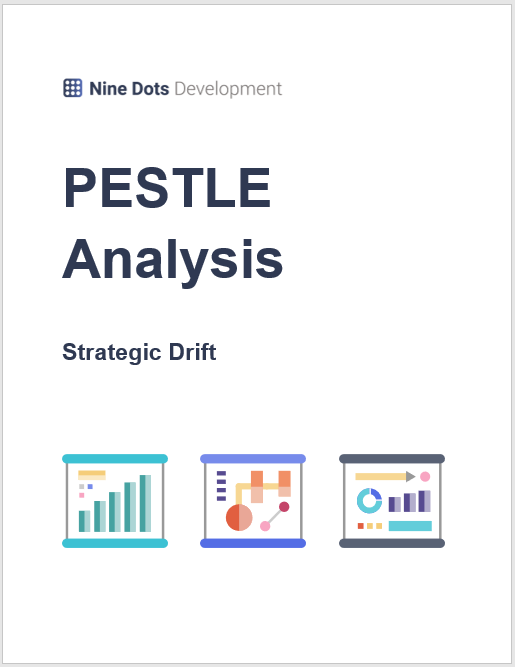Friday 04 Jun 2021 Article
The TakeawayStrategic Drift: Understanding What It Means and Its Impact on Your Organisation
Understanding, Recognising and Avoiding Strategic Drift
Part 1 of 2
#StrategicDrift #PESTLEAnalysis #Template
The perfectly matched resource for this article...
Download our PESTLE Analysis Template!
If you liked the article and are interested in downloading our PESTLE Analysis template, please click below!
Download guide!Playing catchup?
Part 1 of 2 Strategic Drift: Understanding What It Means and Its Impact on Your Organisation
Part 2 of 2 3 Ways to Escape or Avoid Strategic Drift in Your Organisation
Strategic Drift: Understanding What It Means and Its Impact on Your Organisation
Blockbuster, Kodak, Nokia… all businesses that fell victim to strategic drift and never fully recovered if at all.
Strategic drift can be fatal to businesses.
So how can you spot whether your organisation is at risk of experiencing or is already experiencing strategic drift?
What Does the Term ‘Strategic Drift’ Mean?
In 1998, Johnson coined the term ‘Strategic Drift’, where the internal strategy and focus of an organisation begins to drift away from the external environment and doesn’t keep up with external market changes.
Many organisations simply aim to keep up with external pressures but a very few, like Apple, are market leaders, meaning they not only keep up with market changes but they actually start them too.
Why is Being Able to Spot Strategic Drift So Important?
An organisation’s ability to keep up with external changes determines the extent to which it is impacted by these external factors.
Organisations that closely monitor external needs and keep up with them by regularly performing incremental internal changes are likely to be much less severely impacted.
On the contrary, organisations which don’t monitor and keep up with external changes are likely to have to undergo sudden, drastic, last-minute changes as an attempt to catch up with the market which can be extremely disruptive to the organisation’s performance.
Covid-19 is a great example of where being able to adapt to external pressures has been make or break for many organisations.
Some companies quickly adapted their strategy and took action early on and are now thriving.
However, some companies waited too long to review their strategy and are now struggling to catch up with their more proactive competitors.
How Can I Spot Strategic Drift in My Organisation Before it’s Too Late?
Strategic drift can be extremely difficult to spot until it’s too late and your organisation’s strategy is evidently outdated and your business is struggling to stay afloat.
However, it is possible.
The PESTLE Analysis Framework is a really useful tool for considering external factors that do, or could in the future, impact your organisation.
It analyses the 6 key factors that influence organisations from the outside, making you more aware of your market and environment.
Analysing these factors gives you greater insight into external influences that might affect your strategy, helps you foresee and assess potential risks, and enables you to use this knowledge to make better-informed business decisions.
What Does the PESTLE Analysis Framework Consist of?
As we just mentioned, PESTLE looks at 6 crucial types of external factors:
- Political
Tax policy, environmental regulations, trade restrictions and reform, tariffs, political stability - Economic
Economic growth/decline, interest, exchange, inflation and wage rates, minimum wage, working hours, unemployment, credit availability, cost of living - Sociological
Cultural norms and expectations, health consciousness, population growth rates, age distribution, career attitudes, health and safety - Technological
New technology emerging e.g. AI, rate of change, rate of adoption - Legal
Changes in legislation impacting employment, quotas, access to materials, imports and exports, taxation - Environmental
Global warming, sustainable resources, ethical sourcing, supply chain intelligence
Looking at all of these factors can help guide strategic decision-making by showing you which parts of your organisation are impacted by which external changes, and what you need to do to mitigate the potential risks these changes may entail.
Where Do I Start with PESTLE?
To get started, you can download our fantastic PESTLE Analysis template for free by following the link below.
All you need to do is look at each row of the template and fill in the grid with how each external factor affects your industry and how prevalent/important each industry change that you identify is to your organisation.
If you’re struggling for ideas or aren’t sure what your PESTLE Analysis should look like, you can click here to view an example of a completed PESTLE Analysis grid on the CIPD website.
---
In our next article, we will be looking at how you can use the information you have compiled to determine whether your organisation is experiencing strategic drift and how to avoid/escape strategic drift.
We hope you have a great weekend, and we’ll be back on Monday!
Download our PESTLE Analysis Template!
If you liked the article and are interested in downloading our PESTLE Analysis template, please click below!
Download guide!Missed an article? More from Understanding, Recognising and Avoiding Strategic Drift
Part 1 of 2 Strategic Drift: Understanding What It Means and Its Impact on Your Organisation
Part 2 of 2 3 Ways to Escape or Avoid Strategic Drift in Your Organisation

